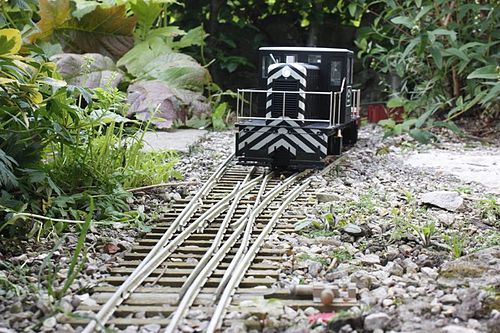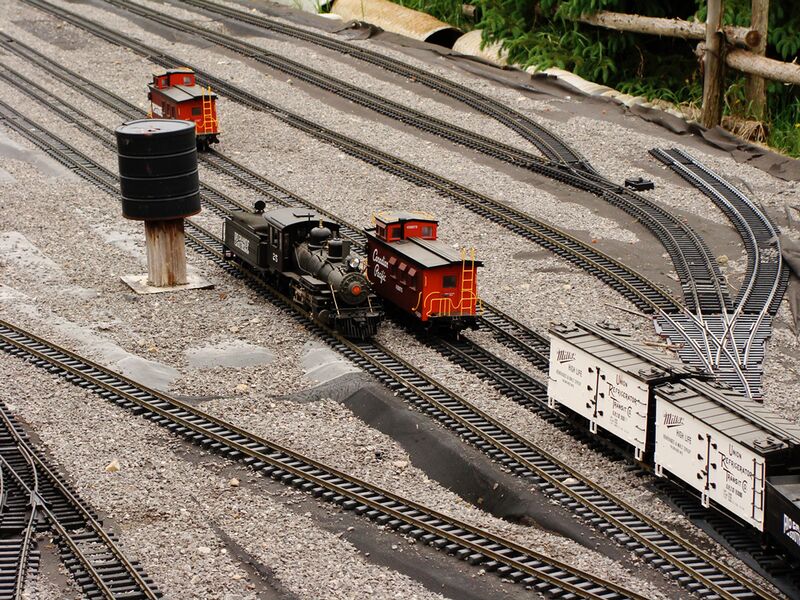Large Scale Trains
Summary: Large Scale is popular for outdoor railroads
| Large Scale |
|
Garden railroads |
Large Scale Model Railroading
G Scale is a popular scale for model railways, particularly garden railways. The name comes from the German grosse. Originally and correctly, G scale is the use of 45mm gauge track, as used in standard gauge I scale (NEM 010), aka 3/8" scale (LS, NMRA S-1.2), for modelling metre gauge narrow gauge railways, using the correct scale of 1:22.5. Metre gauge is the most common narrow gauge in Europe. Because of its size and durability, G scale is often used outdoors. Such installations are known as garden railways.
In the United States, the commonly used narrow gauge is 3 feet (36 inches); modelling this correctly with a 45mm track gauge gives a scale of 1:20.3, (Fn3) which is commonly used by American manufacturers. Correctly speaking, these are not really G scale, but they are frequently called that. Some people call 1:20.3 "F scale". Other scales are used to model other narrow gauges; although some call models of standard gauge equipment to 45mm track gauge 'G scale', these models are actually I scale (NEM) or 3/8" / Large Scale (NMRA).
The major European manufacturer, and the one that really made garden railways popular, is Ernst Paul Lehman Patentwerk, and is sold under the brand name of LGB (Lehmann Grosse Bahn, or "Lehmann Big Train"). The company was founded in 1881 and started producing LGB in 1968. Today it produces models of European and US originals, of steam, diesel and electric prototypes as well as a large range of coaches, trucks and accessories.
Various Sizes within G scale
Dealing with these big trains can be very, very confusing, especially for a beginner. If you don't understand all this, don't worry. This is more of a reference and not meant to be "remembered".
G scale is perhaps the most confusing in terms of scales. It helps to think of it this way first: G is not a scale as such, it's a term to describe "trains running on 45mm gauge track"
With that said, rolling stock ranges from 1:20.3 (narrow gauge scaling out to three feet between the rails) all the way up to 1:32 (standard gauge, or 4 feet 8 1/2 inches between the rails). 1:29 is the most common scale, with the most equipment available, and is accepted as a compromise to standard gauge.
- 1:20.3 (Fn3) is growing in popularity with the release of Bachmann's large-scale narrow-gauge locomotives and rolling stock.
- 1:22.5 is most often associated with LGB layouts.
- 1:24 is not very common, although it is used for large scale buildings and detailing, since dollhouses use this scale.
- 1:32 is true standard gauge, and is used by MTH-Railking.
All scales run on the same gauge track.
Some generalizations (before we get into the manufacturer sizes):
- Old time passenger cars are all over the map scale wise; but most are roughly 1:22.5 (LGB) or 1:20.3 (Bachmann).
- Most of Aristo-Craft's and USA Train's modern (post WW2) freight cars are in 1:29 scale, but some of the old-fashioned cars are closer to 1:24. If it's a wooden car, like an old-fashioned billboard reefer, it's probably closer to 1/24.
And finally, a note about couplers in regards to scale sizes:
For couplers, it's been recommended to switch everything over to Kadee's....but be careful! Kadee makes both 1/32 scale (approximately) and 1/22 scale (again, approximately) couplers for large scale trains. And there's about two billion (slight exaggeration) types of large-scale Kadees, depending on what car or locomotive you're trying to convert.
In short: (Width while on scale → Width effectively used)
| Scale | 1:19 | 1:20.3 | 1:22.5 | 1:24 | 1:29 | 1:32 |
|---|---|---|---|---|---|---|
| NMRA reference (Standard NMRA S1.3) | F | 1:22 | 1:24 | 1:29 | #1 | |
| MOROP reference (Standard NEM 010) | II | I | ||||
| Track, 2 ft | 32 mm | 30->32 mm | - | - | - | - |
| Track, 3 ft | 48->45 mm | 45 mm | - | - | - | 29->32 mm |
| Track, 1000 mm (metre gauge) |
- | 49->45 mm | 45 mm | 42->45 mm | 34->32 mm | 32 mm |
| Track, 1,435 mm (standard gauge) |
- | 70.63 mm | 64 mm | - | 49->45 mm | 45 mm |
| Road cars & trucks | ->1:18 | - | ->1:24 | 1:24 | ->1:32 | 1:32 |
Manufacturers and their Sizes
This list may not be accurate. There may also be some disagreement on these numbers. Please consider this a reference.
Accucraft
They state their scale in their own ads but it is always 1:20.3 for three-foot narrow-gauge prototypes and 1:32 for standard gauge prototypes.
Accucraft live steam British outline stuff, including the new Garrett, are built to the UK garden railway scale of 16mm to the foot, or 1/19th.
- Narrow gauge - 1:20.3
- Standard gauge - 1:32
- All 'classic' series cars are 1:24 (From the old Delton moulds).
Aristocraft
Generally, all new offerings are standard gauge of 1:29 (notwithstanding one recent narrow-gauge railcar in 1:20.3). Older Aristo models representing narrow gauge were done in 1:22.5 and are generally inaccurate or fantasies.
- Generally speaking - 1:29
- "Heavyweight" passenger cars are 1:29 scale.
- Narrow gauge - 1:20.3
- "Classic" series is 1:24
- Older models - 1:22.5 (need source/year cutoff)
Aster
- Generally, 1:32
- 1:30 for Japanese prototypes
- 1:22.5 for European and Japanese narrow gauge
Bachmann
- "Spectrum" locos and some industrial rolling stock is 1:20.3.
- "Big Haulers" series is 1:22.5, as is most their other rolling stock, though it may be inaccurately modeled from the prototype.
Hartland
Nominally 1:24 though often inaccurate models or just plain fantasies.
- Generally speaking - 1:24
- Some 1:29 for their standard gauge equipment.
LGB
Their narrow-gauge models are nominally 1:22.5 but at least as far as North American styled models go, they are generally inaccurate or just fantasies. Their standard gauge offerings are of unknown scale though often about 1:26 and are frequently inaccurate or fantasies. The most recent offerings like the Genesis are standard gauge and appear to be fairly accurate 1:29 models. LGB of America has indicated that future sg models would be accurately scaled to 1:29.
- (Older) Narrow gauge - 1:22.5
- (Older) Standard gauge - Unknown, estimated at 1:26
- Newer items in 1:29
Märklin
- "MAXI" is 1:32
MTH
- Rail-King is 1:32
Northern Fine Scale Stock
Northern Fine Scale is 10mm (1:30) scale British only freight stock in kit form.
Piko
- Ranges from 1:27 - 1:29
USA Trains
Most of their offerings including all the recent ones are sg and are accurate models rendered in 1:29. Their old models of ng equipment are done in 1:22.5 and are more or less fantasies.
- Usually in 1:29
- USA Steamline passenger cars - 1:29
- "American" series is 1:24
- 'Older' models in 1:22.5
Wrightway Rolling Stock
1:32 and 10mm (1:30) scale custom built British North American and European passenger stock.
Notes
The NMRA has definitions for Large Scale in both standard and narrow gauges: LS and LSn3. In either example, the scale is 0.375"/9.52mm to the foot, with the track gauge being 45mm (nominal).
Neither scale designation includes a common/fraction scale or a proportion, as both can vary.



